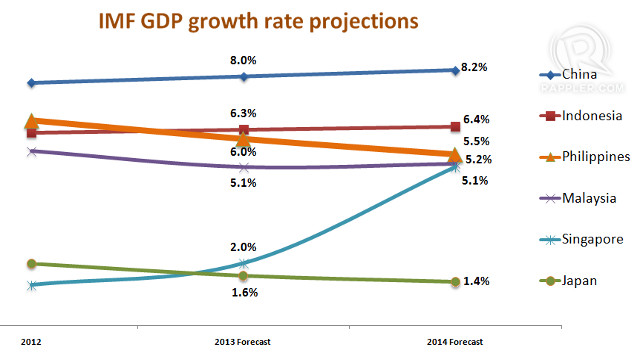SUMMARY
This is AI generated summarization, which may have errors. For context, always refer to the full article.

MANILA, Philippines – Despite election-related spending, the International Monetary Fund (IMF) said Philippine economic growth would slow down in 2013, and in 2014.
In the main chapters of its World Economic Outlook, IMF said the economy would grow 6% in 2013 and 5.5% in 2014, after growing 6.6% in 2012.
IMF’s forecasts are the same as what the Asian Development Bank (ADB) gave in its Asian Development Outlook.
The national government targets growth of 6% to 7% in 2013, and 6.5% to 7.5% in 2014.
“Growth in the ASEAN-5 economies will remain strong at 6% in 2013, reflecting resilient domestic demand,” noted IMF. “Robust remittance flows and low interest rates should continue to support private consumption and investment in the Philippines.”
IMF added that inflation would be within the government’s 3% to 5% target in 2013 and 2014. The lender sees inflation hitting 3.1% in 2013, and inching up to 3.2% in 2014.
In terms of employment, it expects no change in the level of joblessness in the country. IMF expects an unemployment rate of 7% in 2013 and 2014, the same level in 2012.
Risks
IMF meanwhile warned that considerable risks remain. If the global economy would severely slow down, the region could see lower investments and exports, it said.
Fiscal tightening and easing growth in advanced economies could cause a one percentage point reduction in the average growth of emerging Asia in 2015 and 2016.
![]()
“In the event of a severe global slowdown, falling external demand would exert a powerful drag on Asia’s most open economies, including through the second-round impact of lower investment and employment in export-oriented sectors,” IMF said.
IMF projects Asia’s growth to pick up to 5.7% in 2013 and 6% in 2014 on the back of solid domestic demand and recovering external demand. Growth would be boosted by the ASEAN-5 economies, which are expected to post an average growth of 5.9% in 2013, and 5.5% in 2014, it said.
The lender said growth in Asia would also be driven by favorable market conditions and “relatively easy financial conditions.”
“The latter reflect a combination of accommodative monetary policies; rapid credit growth, particularly in some members of the ASEAN; and continued robust capital inflows, which last year helped push stock prices up by 10 to 20% across most of the region.” – with reports from Cai Ordinario and Ramon Calzado/Rappler.com
Add a comment
How does this make you feel?
There are no comments yet. Add your comment to start the conversation.